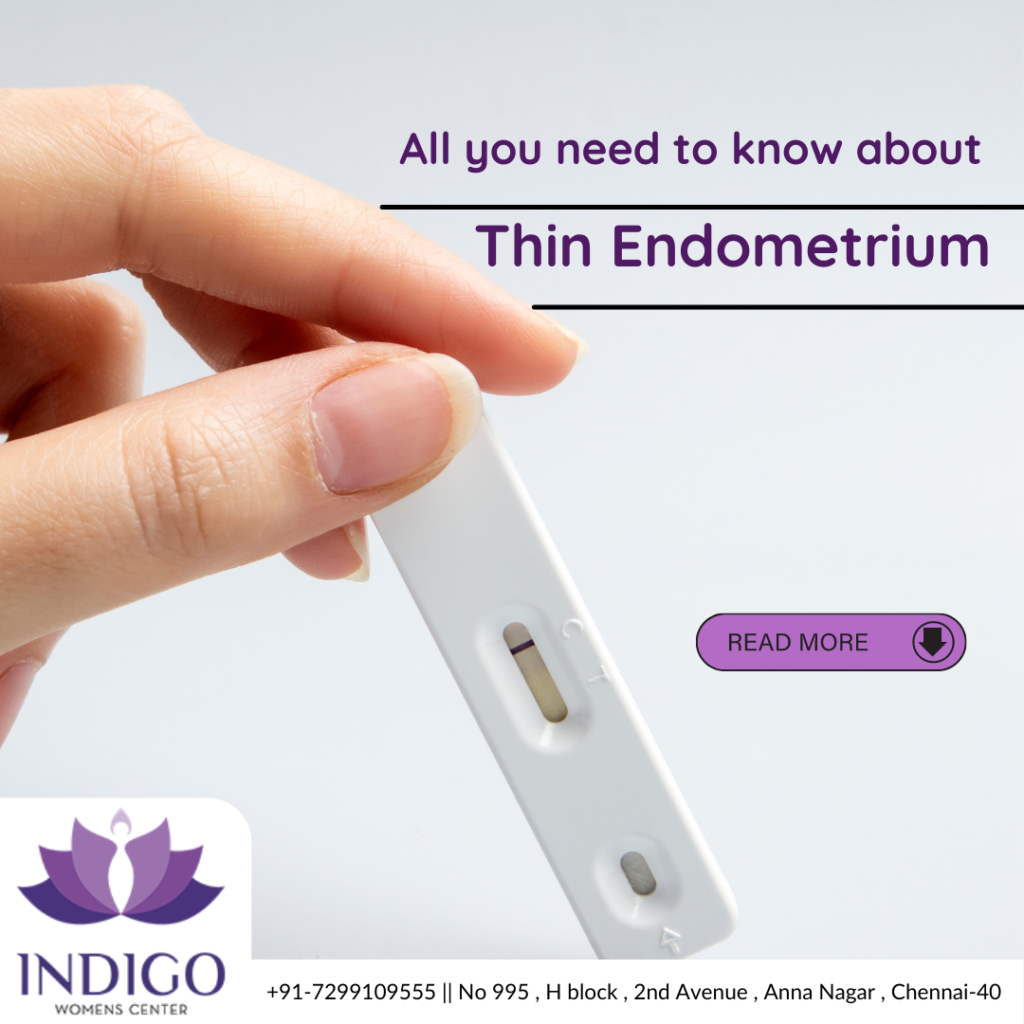Thin endometrium is caused by a diminished normal endometrial growth. Acute or chronic infection like genital tuberculosis may result in destruction of endometrium basal layer due to replacing healthy endometrium by fibroid tissue after healing.Iatrogenic thin endometrium can be occurred by surgical procedures such as repeated curettage, polypectomy, laparoscopic or hysteroscopic myomectomy or with drug usage like clomiphene citrate.It is also indicated that thin endometrium may be a result of individual uterine structural pattern. Asherman’s syndrome is one of the causes of thin endometrium. Impaired uterine perfusion is the reason for atrophy of the remaining endometrium due to restricted exposure to circulating hormones. This syndrome may occur followed myometrial fibrosis that is remarkably increased among women with intrauterine adhesions.
Angiogenesis plays a key role in different female reproductive developments, including growth of dominant follicles, formation of a corpus luteum, and endometrial pattern. Endometrial angiogenesis is vital for regeneration endometrium after menstruation and to provide a vascularized receptive endometrium for implantation. Studies have focused on vascular endothelial growth factor (VEGF) as a regulator for endometrial angiogenesis, and a number of works stated that VEGF is expressed differentially in the uterus with thin endometrium. Uterine blood flow is an essential marker regulating endometrial growth and is narrowly related to vascular development of the endometrium Recent improvements in ultrasonography have provided new opportunities for noninvasive evaluation of endometrial perfusion. A significant reduced pregnancy rate in IVF-ET patients with low uterine blood flow, displayed a close relationship between uterine blood flow and uterine receptivity .
Treatment of thin endometrium
Since a thin endometrium is a multifactorial condition, its management should be cause-related, with the aim of increasing endometrial receptivity and simplifying implantation
Estradiol
Infertile patients, who display inadequate endometrium thickness, will be initially treated with oral estradiol. As the endometrium is a hormone dependent tissue estrogen supports endometrial proliferation by causing spiral artery contraction and decreasing oxygen tension in the functional layer, that simplifies embryo implantation. The best method for prescription of estradiol is oral administration, and there are no significant differences between micronized estradiol or estradiol valerate . According to a meta-analysis results, administration of pure ethinyl estradiol (EE) for treatment of thin endometrium, increase the endometrial thickness in comparison to patients whom used placebo. Moreover, the best result were achieved while EE administration is starting on 7th–10th day of menstrual cycle with the dose of 0.02–0.05 mg/day for 5 days. As the highest serum and endometrial level of estrogen occur after vaginal administration, it is considered as the desirable route in cases that do not respond to the other ways. Oral estrogens were also used for endometrium preparation in FET, where prior IVF failure was believed to be due to thin endometrium.
Human chorionic gonadotropin (HCG)
HCG play a local paracrine role in the endometrium differentiation and endometrial receptivity by regulating different cytokines and growth factors. Papanikolaou and colleagues recruited seventeen infertile patients with the history of implantation failures and resistant thin endometrium. On day 8 or 9 of the estrogen administration (8 mg daily), hCG injection was started subcutaneously by 150 IU daily for 7 days. After a week on hCG priming, on the day 14 or 15 of cycle, the mean endometrial thickness improved by 0.8 mm. Adding hCG to frozen thawed embryo transfer cycles with history of thin endometrium was examined in 28 patients who had two previous failed cycles because of thin endometrium. 150 IU hCG was administrated intramuscularly from the day 8 of cycle until endometrial thickness reached at least 7 mm. The study suggested that adding hCG to the conventional method is effective and improved endometrial thickness and pregnancy outcomes significantly.
Midluteal GnRH-agonist
According to the evidence that mid-luteal GnRH-agonist administration improve pregnancy rate.Triptorelin (0.1 mg) on the day of ovum pickup, day of embryo transfer and three days afterward . The results indicated that treatment with GnRH-a increases the implantation and pregnancy rate significantly as the same as E2, progesterone levels and endometrial thickness.
Aspirin
The effect of low dose aspirin on pregnancy rate is still debated in the literatures. Even though some studies reported the positive impact of low dose aspirin on endometrial thickness, pattern, and endometrial blood flow, others claimed that aspirin do not increase success of implantation.
Sildenafil
Sildenafil citrate -an inhibitor of cGMP specific phosphodiesterase type 5 (PDE5)- prevents the breakdown of cGMP and increases the effect of nitric oxide on vascular smooth muscles. Sildenafil citrate administration cause an improvement in uterine blood flow and, in combination with estrogen, could lead to the estrogen-induced proliferation of the endometrial lining. The expression of vascular endothelial growth factor (VEGF) and Tumor suppressor factor (p53) genes are essential for breaking down the endometrial cellular matrix, normalize cell growth, and induce angiogenesis. These process are required for adequate endometrial blood supply and consequent embryo implantation . Sildenafil citrate causes significant increases in p53 activity and stimulated angiogenic reactions with elevated VEGF . Studies suggest that the oral and vaginal usage of sildenafil citrate is a good approach to improve the endometrial receptivity.
Vitamin E and pentoxifylline
The combination of pentoxifylline (PTX) as a derivative of methylxanthine that induce vasodilatation and vitamin E as an antioxidant was used for treatment of thin endometrium. This combination was given to oocyte recipients with inadequate endometrial thickness after vaginal E2 administraion. Pentoxifylline has been used clinically in the treatment of vascular abnormalities, and is also a good choice for radiation-induced fibrosis.
Granulocyte colony stimulating factor (G-CSF)
Effect Of G-CSF on Endometrium
In endometrium G-CSF is secreted apically in polarized epithelial cells.
-GCSF has been proposed as a treatment for implantation failure and repeated miscarriages. A growth support in endometrial thickness can be observed within 48 hours of G-CSF administration. Diagnosis of unresponsive thin endometrium :<7mm by ultrasound on the day of Hcg administration.G-CSF Endometrial Infusion: 300mcg/1ml (Filgastrim) approximately 6-12 hrs before Hcg administration and Repeated G-CSF infusion if endometrium <7mm on day of ovum pickup G-CSF may increase the endometrial thickness and the chance of pregnancy in the patient with extremely thin endometrium. Infusion of G-CSF in endometrial cavity is safe and possibly effective to increase endometrial growth in patient with thin and unresponsive endometrium . Endometrial perfusion with G-CSF is effective in expanding unresponsive thin endometrium to at least minimal thickness of 7 mm, which was resistant to estrogen and vasodilators. A growth occurred in endometrial thickness can be detected within 48–72 h of G-CSF administration. This approach in infertile women on the day of hCG administration and in combination with second fusion resulted in low but very reasonable clinical pregnancy rate.
Platelet-rich plasma (PRP)
PRP is blood plasma prepared from fresh whole blood that has been supplemented with platelets. It is collected from peripheral veins and contains several growth factors and cytokines . 15 ml of venous blood taken from the syringe pre-filled with 5 ml of anticoagulant solution (ACD-A), and centrifuged immediately at 200* g for 10 min. The blood was divided into three layers: red blood cells at the bottom, cellular plasma in the supernatant and a buffy coat layer between them. The plasma layer and buffy coat to be collected to another tube and re-centrifuged at 500* g for 10 min. The resulting pellet of platelets to be mixed with 1 ml of supernatant, and then 0.5-1 ml of PRP was obtained. As soon as platelets are motivated in PRP, cytokines and growth factors turn out to be active and are secreted within 10 min. Recently, PRP has been commonly applied in different clinical situations; however, little is identified about the application of PRP in the treatment of thin endometrium.PRP prepared from autologous blood by centrifugation, and infusion of 0.5–1 ml of PRP into the uterine cavity on the 10th day of HRT cycle performed. If endometrial thickness failed to improve 72 h later, PRP infusion to be done 1–2 times in each cycle. Embryos to be transferred while the endometrium thickness reached more than 7 mm. Endometrial growth as well as successful pregnancy was occurred in all the patients after PRP infusion .
In conclusion, a receptive endometrium is an essential part of embryo implantation process, and inadequate endometrial growth is associated with lower possibility of pregnancy. Many treatment modalities have been applied to improve endometrial receptivity, but their efficacy remains controversial. Large randomized trials should be conducted to evaluate method, dosage, timing of administration and outcomes of these treatment approaches. Stem cell therapy is considered as a very favorable option for the most cases, even though, more investigation is necessary to evaluate the safety and cost-effectiveness of this technique. ERA is an accurate test for diagnosing endometrial receptivity and could establish a personalized window of implantation in cases with thin endometrium.





